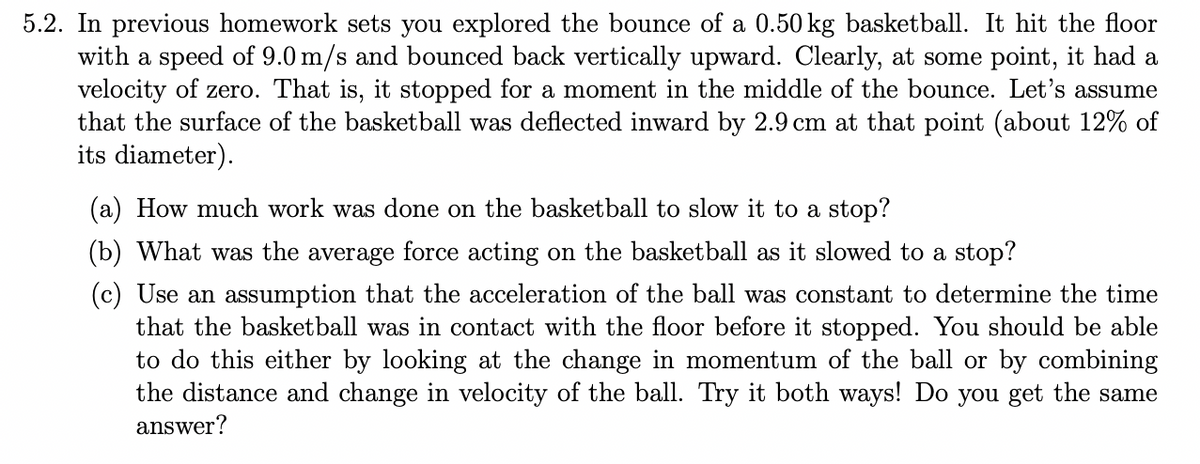5.2. In previous homework sets you explored the bounce of a 0.50 kg basketball. It hit the floor with a speed of 9.0 m/s and bounced back vertically upward. Clearly, at some point, it had a velocity of zero. That is, it stopped for a moment in the middle of the bounce. Let's assume that the surface of the basketball was deflected inward by 2.9 cm at that point (about 12% of its diameter). (a) How much work was done on the basketball to slow it to a stop? (b) What was the average force acting on the basketball as it slowed to a stop? (c) Use an assumption that the acceleration of the ball was constant to determine the time that the basketball was in contact with the floor before it stopped. You should be able to do this either by looking at the change in momentum of the ball or by combining the distance and change in velocity of the ball. Try it both ways! Do you get the same answer?
5.2. In previous homework sets you explored the bounce of a 0.50 kg basketball. It hit the floor with a speed of 9.0 m/s and bounced back vertically upward. Clearly, at some point, it had a velocity of zero. That is, it stopped for a moment in the middle of the bounce. Let's assume that the surface of the basketball was deflected inward by 2.9 cm at that point (about 12% of its diameter). (a) How much work was done on the basketball to slow it to a stop? (b) What was the average force acting on the basketball as it slowed to a stop? (c) Use an assumption that the acceleration of the ball was constant to determine the time that the basketball was in contact with the floor before it stopped. You should be able to do this either by looking at the change in momentum of the ball or by combining the distance and change in velocity of the ball. Try it both ways! Do you get the same answer?
Related questions
Question
Please show or state thinking

Transcribed Image Text:5.2. In previous homework sets you explored the bounce of a 0.50 kg basketball. It hit the floor
with a speed of 9.0 m/s and bounced back vertically upward. Clearly, at some point, it had a
velocity of zero. That is, it stopped for a moment in the middle of the bounce. Let's assume
that the surface of the basketball was deflected inward by 2.9 cm at that point (about 12% of
its diameter).
(a) How much work was done on the basketball to slow it to a stop?
(b) What was the average force acting on the basketball as it slowed to a stop?
(c) Use an assumption that the acceleration of the ball was constant to determine the time
that the basketball was in contact with the floor before it stopped. You should be able
to do this either by looking at the change in momentum of the ball or by combining
the distance and change in velocity of the ball. Try it both ways! Do you get the same
answer?
Expert Solution
This question has been solved!
Explore an expertly crafted, step-by-step solution for a thorough understanding of key concepts.
Step by step
Solved in 5 steps
